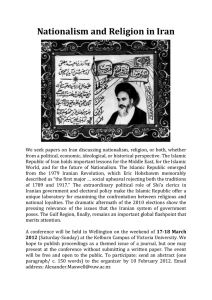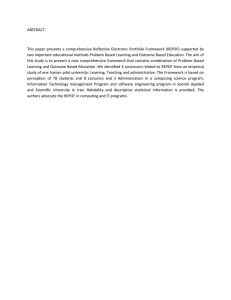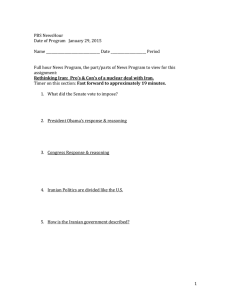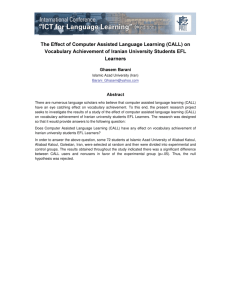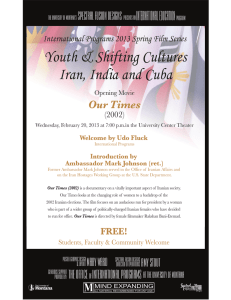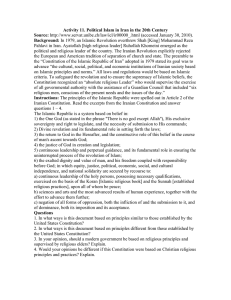Chapter 13 Iran
advertisement
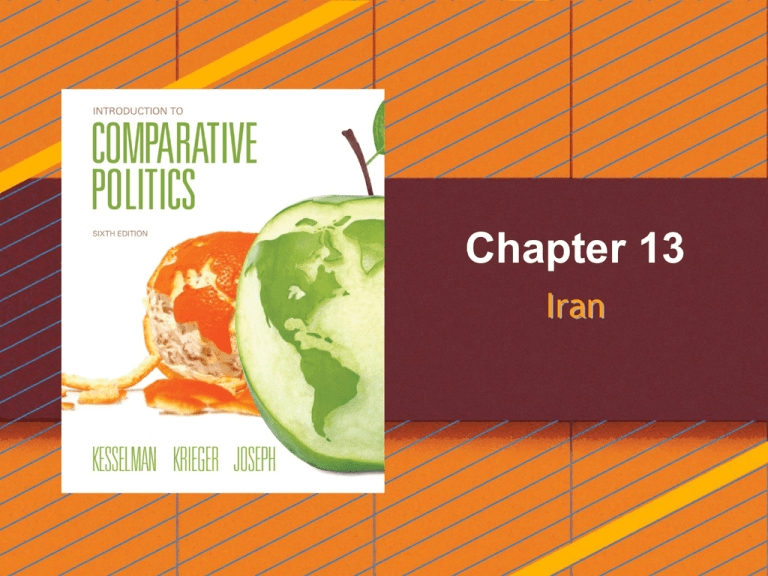
Chapter 13 Iran SECTION 1 THE MAKING OF THE MODERN IRANIAN STATE Copyright © Cengage Learning. All rights reserved. 12 | 2 THE MAKING OF THE MODERN IRANIAN STATE Politics in Action • Contrasting Iranian elections – Election of 1997: Muhammad Khatami elected President. o Middle ranking cleric, not ayatollah o Ayatollah—literally “sign of God”; high-ranking cleric. Campaign promises Create a more open civil society. Civil society—space occupied by voluntary associations outside the state; e.g., trade unions To protect individual liberties, freedom of expression, women’s rights, political pluralism, and rule of law Copyright © Cengage Learning. All rights reserved. 12 | 3 THE MAKING OF THE MODERN IRANIAN STATE Copyright © Cengage Learning. All rights reserved. 12 | 4 THE MAKING OF THE MODERN IRANIAN STATE Copyright © Cengage Learning. All rights reserved. 12 | 5 THE MAKING OF THE MODERN IRANIAN STATE Politics in Action (Cont’d) • – Contrasting Iranian elections (Cont’d) Election of 2005: Mahmoud Ahmadinejad elected president o Ultra-conservative, populist o Campaign promises – Reduce poverty Promote social justice End corruption Reverse liberal changes implemented under Khatami o Denounced West as “decadent” Re-elected in 2009 in controversial election o Mass protests o Widespread accusations of ballot rigging Copyright © Cengage Learning. All rights reserved. 12 | 6 THE MAKING OF THE MODERN IRANIAN STATE Politics in Action (Cont’d) • Contradictory political forces at work – Written constitution tries to synthesize: o o o Theocracy and democracy; Spiritual authority and popular sovereignty Theocracy—state dominated by the clergy, who rule on the grounds that they are the only interpreters of God’s will and law. Divine rights and human rights Although they have regular elections for the presidency and Majles (Parliament), the clerically dominated Guardian Council determines who can run. Majles—Iranian parliament, from the Arabic term for “assembly”. Guardian Council—a committee created in the Iranian constitution to oversee the Majles (the parliament) Copyright © Cengage Learning. All rights reserved. 12 | 7 THE MAKING OF THE MODERN IRANIAN STATE Politics in Action (Cont’d) • Contradictory political forces at work (Cont’d) – o o The President President is formal head of executive branch, but can be overruled, and even dismissed, by the Leader / Supreme Leader. Leader/Supreme Leader—Cleric elected to be the head of the Islamic Republic of Iran. Appoints the minister of justice Whole judiciary is under the supervision of chief judge who is appointed by the Leader. – The Majles is the legislature, but bills do not become law unless the Guardian Council deems them compatible with Islam and the Islamic constitution. Copyright © Cengage Learning. All rights reserved. 12 | 8 THE MAKING OF THE MODERN IRANIAN STATE Geographic Setting • Most of Iran is inhospitable to agriculture. – – – • Bordered by Great Salt Desert and two mountain ranges Rain-fed agriculture confined mostly to northwest and provinces along the Caspian Sea Only pastoral nomads survive in semiarid zones and high mountain valleys. Iran is the second-largest oil producer in the Middle East and fourth in the world. – Middle-income country Copyright © Cengage Learning. All rights reserved. 12 | 9 THE MAKING OF THE MODERN IRANIAN STATE Copyright © Cengage Learning. All rights reserved. 12 | 10 THE MAKING OF THE MODERN IRANIAN STATE Geographic Setting (Cont’d) • Iran lies on strategic crossroads areas, making it vulnerable to invasion. – – – Central Asia and Turkey Indian subcontinent and Middle East Arabian Peninsula and Caucasus Mountains o • Considered boundary between Europe and Asia Population reflects invasions. – Majority speak Farsi. o Farsi—Persian word for the Persian language. Farsi is a province in Central Iran. Copyright © Cengage Learning. All rights reserved. 12 | 11 THE MAKING OF THE MODERN IRANIAN STATE Copyright © Cengage Learning. All rights reserved. 12 | 12 THE MAKING OF THE MODERN IRANIAN STATE Copyright © Cengage Learning. All rights reserved. 12 | 13 THE MAKING OF THE MODERN IRANIAN STATE • shari’a —Islamic law derived mostly from the Qur’an and the examples set by the Prophet Muhammad. Copyright © Cengage Learning. All rights reserved. 12 | 14 THE MAKING OF THE MODERN IRANIAN STATE Critical Junctures The Safavids (1501–1722) • Safavid family conquered territory that is now Iran in sixteenth century. – Forcibly converted subjects to Shi’ism o Shi’i communities had existed in area but majority adhered to Sunni. Copyright © Cengage Learning. All rights reserved. 12 | 15 THE MAKING OF THE MODERN IRANIAN STATE The Safavids (1501–1722) (Cont’d) • Minorities included Sunni, Jews, Zoroastrians, Christians. – o Minorities were tolerated if they paid special taxes, accepted royal authority. Minorities tolerated as legitimate “People of the Book” • Copyright © Cengage Learning. All rights reserved. People of the Book—The Muslim term for recognized religious minorities, such as Christians, Jews, and Zoroastrians. Mentioned in Qur’an, had their own sacred texts Qur’an—The Muslim Bible. Safavids claimed absolute power, but lacked central state. 12 | 16 THE MAKING OF THE MODERN IRANIAN STATE The Qajars (1794–1925) • Afghan tribesmen invaded in 1722. – After half-century of civil war, reconquered much of Iran. o Recreated Safavid system of central manipulation and court administration, including Persian scribes Declared Shi’ism to be state religion o • Qajar rule coincided with European imperialism. • – Russian invasions established current borders. – British Imperial Bank won monopoly to issue paper money. – Indo-European Telegraph Company got contract to extend communication lines throughout the country. – Oil rights in southeast were sold to British citizen. Resentments led to Constitutional Revolution of 1905– 1909. Copyright © Cengage Learning. All rights reserved. 12 | 17 THE MAKING OF THE MODERN IRANIAN STATE The Qajars (1794–1925) (Cont’d) • 1906 constitution – – – – – Introduced elections Separation of powers Laws made by a legislative assembly Concepts of popular sovereignty and the nation (mellat) Maintained monarchy, but centered political power in national assembly, called Majles. o o o Majles had authority over all laws, budgets, treaties, loans, concessions, and make-up of cabinet. o Constitution contained a bill of rights. Guaranteeing equality before the law, protection of life and property, safeguards from arbitrary arrest, and freedom of expression and association. Shi’ism declared Iran’s official religion. Guardian Council was given veto power. Copyright © Cengage Learning. All rights reserved. 12 | 18 THE MAKING OF THE MODERN IRANIAN STATE The Qajars (1794–1925) (Cont’d) • Initial euphoria gave way to disillusionment. – – – o Liberals favored social reform including replacement of shari’a. – o European pressure continued. Famine Majles polarized into liberal and conservative factions Central government lacked army, bureaucracy, tax-collecting Unable to administer provinces • • Russia and Britain divided Iran into three zones during World War I. Iran in disarray by 1921 Copyright © Cengage Learning. All rights reserved. 12 | 19 THE MAKING OF THE MODERN IRANIAN STATE The Pahlavis (1925–1979) • 1921 General Reza Khan carried out military coup d’état. – – Coup d’état: A forceful, extra-constitutional action resulting in the removal of an existing government. 1925: Deposed Qajars, crowned himself shah-in-shah (king of kings) o o – Established Pahlavi dynasty; first nontribal dynasty in Iran Transfer of power endorsed by Majles. Ruled until 1941, when British and Soviets invaded Iran o Abdicated to son and went into exile Copyright © Cengage Learning. All rights reserved. 12 | 20 THE MAKING OF THE MODERN IRANIAN STATE The Pahlavis (1925–1979) (Cont’d) • Muhammad Reza Shah retained control over armed forces – – Had to tolerate free press, independent judiciary, competitive elections Two vigorous political movements: o o • • Muhammad Mosaddeq elected prime minister 1951. Overthrown in 1953 when shah was installed with absolute power. – • Tudeh—communist; mainly trade unions National Front—drew support from salaried middle class; nationalistic Led by Dr. Muhammad Mossadeq Coup was financed by United States (CIA) and Britain. 1979: Islamic Revolution; Shah overthrown Copyright © Cengage Learning. All rights reserved. 12 | 21 THE MAKING OF THE MODERN IRANIAN STATE The Pahlavis (1925–1979) (Cont’d) • Pahlavi dynasty built a highly centralized state. – Rested on pillars of armed forces, bureaucracy, royal patronage o – – Justice Ministry supplanted shari’a with civil code and modern judicial system White Revolution designed to prevent communist-led revolution o – Establishment of state-subsidized, tax-exempt Pahlavi Foundation Included agricultural reforms and women’s suffrage State controlled major institutions including banks, media, oil. Copyright © Cengage Learning. All rights reserved. 12 | 22 THE MAKING OF THE MODERN IRANIAN STATE The Pahlavis (1925–1979) (Cont’d) • Secularization, centralization, industrialization, and social development – – – – • Gained favor from urban propertied class Disregard for constitutional liberties State appeared strong because controlled coercion and administration Did not link institutions to social structure Shah formed Resurgence Party 1975. – – – Declared country one-party state Threatened imprisonment and exile if refuse to join party Designed to give organizational link to population, especially bazaars (traditional marketplaces). Copyright © Cengage Learning. All rights reserved. 12 | 23 THE MAKING OF THE MODERN IRANIAN STATE The Islamic Revolution (1979) • Anti-shah cleric Khomeini formulated new version of Shi’ism, labelled Islamic fundamentalism (also referred to as political Islam or Shi’i populism. – – – Fundamentalism—term used to describe radical religious movements through the world. Political Islam—intermingling of religion with politics ; often used as a substitute for fundamentalism. Denounced monarchies as part of corrupt, exploiting masses Copyright © Cengage Learning. All rights reserved. 12 | 24 THE MAKING OF THE MODERN IRANIAN STATE The Islamic Revolution (1979) • Gave new meaning to Shi’i term for jurist’s guardianship – Jurist’s guardianship—Khomeini’s concept that the Iranian clergy should rule on the grounds that they are the divinely appointed guardians of both the law and the people. He developed this concept in the 1970s. – Gave senior clergy all-encompassing authority over whole community – Only senior clerics had competence to understand shari’a. – Clergy were people’s true representatives. Copyright © Cengage Learning. All rights reserved. 12 | 25 THE MAKING OF THE MODERN IRANIAN STATE The Islamic Revolution (1979) (Cont’d) • Minor economic difficulties and international pressure concerning human rights violations 1977 – – • Shah cut construction projects, declared war against profiteers. Human rights pressure gave opposition opening. Bloody Friday September 8, 1978 – – Troops killed unarmed demonstrators. General strike brought economy to halt by late 1978. Copyright © Cengage Learning. All rights reserved. 12 | 26 THE MAKING OF THE MODERN IRANIAN STATE The Islamic Revolution (1979) (Cont’d) • Local communities met social needs in urban centers. – – Food was distributed to the needy by communities attached to mosques and funded by bazaars. Supplanted police with militias known as pasdaran o – • Pasdaran—Persian term for guards, used to refer to army of Revolutionary Guards formed during Iran’s Islamic Revolution. Replaced judicial system with shari’a courts Participation at demonstrations increased. – Led by pro-Khomeini clerics, but broad support Copyright © Cengage Learning. All rights reserved. 12 | 27 THE MAKING OF THE MODERN IRANIAN STATE The Islamic Republic (1979–present) • Nationwide referendum replaced monarchy with Islamic Republic. – • Khomeini overruled option of democratic Islamic Republic, arguing that Islam was democratic. New constitution was crafted by Assembly of Experts. – – Assembly of Experts —Nominates the Supreme Leader and can replace him. The assembly is elected by the general electorate, but almost all its members are clerics. Elected under boycott by secular organizations and antiKhomeini clerics, media control, voter intimidation by Hezbollahis (“Partisans of God”) o Hezbolliahis—In Iran, religious vigilantes. . Copyright © Cengage Learning. All rights reserved. 12 | 28 THE MAKING OF THE MODERN IRANIAN STATE The Islamic Republic (1979–present) (Cont’d) • New constitution was crafted by Assembly of Experts. (Cont’d) – Majority elected, including hojjat al-Islams (“the proof of Islam”), were pro-Kohmeini clergymen. o – – Highly theocratic with Khomeini having majority of authority Bazargan wanted French-style presidential republic Islamic in name, but democratic in structure. o – Undermined when threatened to submit alternate constitution Khomeini instigated anti-American sentiment leading to hostage crisis. o • – – Hojiat al-Islams—medium ranking cleric. Thought to be orchestrated to ratify constitution Khomeini submitted constitution to public. Declared citizens had divine duty to vote Constitution passed, but support eroded Copyright © Cengage Learning. All rights reserved. 12 | 29 THE MAKING OF THE MODERN IRANIAN STATE Copyright © Cengage Learning. All rights reserved. 12 | 30 THE MAKING OF THE MODERN IRANIAN STATE The Islamic Republic (1979 to Present) (Cont’d) • Factors that helped clerics consolidate power in first decade – – – • Khomeini’s overwhelming charisma and popularity Iraqi invasion of Iran in 1980 Increased oil prices Second decade held challenges. – Khomeini’s death June 1989 o – – – Successor lacked charisma and credentials. 1988 United Nations brokered cease-fire, ended Iran-Iraq War. Fall in oil prices Ideological crisis by late 1990s o Democracy over theocracy Copyright © Cengage Learning. All rights reserved. 12 | 31 THE MAKING OF THE MODERN IRANIAN STATE Iran After 9/11 • Terrorist attacks, invasion of Afghanistan and Iraq has profound effect on Iran. – At first brought Iran and United States closer o o – – United States antagonized Iran by including it in the Axis of Evil. Tried to pressure Iran to stop nuclear research o • Iran saw Taliban and Hussein as enemy. Iran helped in both Iraq and Afghanistan. Tensions played major role in Ahmadinejad election. Reformers could not be associated with potential coup. Conservatives wanted to stand up to United States. United States and Iran: stalemate – – United States would like to see “behavioral” or regime change, but needs Iran’s cooperation in keeping Iraq in control. Iran has oil, regional position. Copyright © Cengage Learning. All rights reserved. 12 | 32 THE MAKING OF THE MODERN IRANIAN STATE Themes and Implications Historical Junctures and Political Themes • Khomeinism has divided into two divergent branches: – – Political liberalism Clerical conservatism • Iran inadvertently prompted Saddam Hussein to launch the Iraq-Iran War in 1980. – – Denounced United States as “arrogant imperialist Held United States diplomats as hostages Copyright © Cengage Learning. All rights reserved. 12 | 33 THE MAKING OF THE MODERN IRANIAN STATE Historical Junctures and Political Themes (Cont’d) • Acts that isolated Iran from United States, European Community, human rights organizations, and the United Nations – – – – – • Denounced Saudi Arabia as “corrupt puppets of American imperialism” Bought nuclear subs from Russia Denounced proposals for Arab-Israeli negotiations over Palestine Sent money and arms to Muslim dissidents Permitted intelligence services to assassinate some one hundred exiled opposition leaders living in Western Europe Iran unlikely to be able to develop nuclear weapons in the near future. – Successful joint U.S.-Israeli cyber-sabotage program Copyright © Cengage Learning. All rights reserved. 12 | 34 THE MAKING OF THE MODERN IRANIAN STATE Historical Junctures and Political Themes (Cont’d) • In 1980s Islamic Republic dealt with many issues, such as: – – – Lack of both agricultural land and irrigation Industry suffered lack of investment capital High inflation and unemployment o o Some leaders favored state-interventionist strategies. Others favored laissez-faire market-based strategies. Laissez-faire —term taken from the French, which means “to let be,” in other words, to allow to act freely. Copyright © Cengage Learning. All rights reserved. 12 | 35 THE MAKING OF THE MODERN IRANIAN STATE Implications for Comparative Politics • • – – – – Islamism—new term for the use of Islam as a political ideology. Similar to political Islam and fundamentalism. Bitter conflict exists on two contrasting interpretations of Islam. Between reformers and conservatives Between so-called fundamentalists and liberal pragmatists Between supporters of Khatami and those of Ahmadinejad Between the generation that made the 1979 revolution and new generation that came of age during the revolution Copyright © Cengage Learning. All rights reserved. 12 | 36 SECTION 2 POLITICAL ECONOMY AND DEVELOPMENT State and Economy • Oil financed over 90 percent of imports in Iran during the ‘70s. – Oil revenues made Iran into a rentier state. o Rentier state —country that obtains much of its revenue from the export of oil or other natural resources. Copyright © Cengage Learning. All rights reserved. 12 | 37 POLITICAL ECONOMY AND DEVELOPMENT Iran’s Economy under the Islamic Republic • Iran’s main economic problem has been instability in the world oil market. – • Oil revenues provide 80 percent of hard currency. Economic difficulties resulting in twenty-two year economic crisis lasting into 1990s: – – – – Population explosion Iran-Iraqi War Emigration of some three million Iranians Technicians and professional fled to West after revolution. • Some successes – – – Reconstruction of Ministry—roads, schools, libraries Agricultural Ministry—redistribution of lands to poor Government—allowing privatization Copyright © Cengage Learning. All rights reserved. 12 | 38 POLITICAL ECONOMY AND DEVELOPMENT Society and Economy • • During Shah’s reign, huge state investment into social welfare. Shah’s approach to development decreased his popularity. – Believed if economic growth benefited wealthy, it would trickle down—it did not. o High inequality by mid-1970s; resulted in dual society Dual society—A society and economy that are sharply divided into a traditional, usually poorer, and modern, usually richer, sectors. Each sector stratified into unequal classes Increased fueled resentment, expressed more in cultural and religious terms than in economic and class terms Copyright © Cengage Learning. All rights reserved. 12 | 39 POLITICAL ECONOMY AND DEVELOPMENT Copyright © Cengage Learning. All rights reserved. 12 | 40 POLITICAL ECONOMY AND DEVELOPMENT Copyright © Cengage Learning. All rights reserved. 12 | 41 POLITICAL ECONOMY AND DEVELOPMENT Society and Economy • Life has improved for most Iranians. – – – – – – Extension of social services narrowed gap between town and country. Literary rate for ages six to twenty-nine hit 97 percent. Infant mortality rate fell. Life expectancy climbed from fifty-five to sixty-eight. 94 percent of population had access to health services. Major strides toward population control Copyright © Cengage Learning. All rights reserved. 12 | 42 POLITICAL ECONOMY AND DEVELOPMENT Copyright © Cengage Learning. All rights reserved. 12 | 43 POLITICAL ECONOMY AND DEVELOPMENT Iran in the Global Economy • Iran began integrating into world system in latter half of nineteenth century. – • Opening of Suez Canal, Batum-Baku railway, telegraph lines, European capital outflow, Industrial Revolution Contact with West had repercussions. – – Economy dependent on world market fluctuations Exports reduced acreage available for domestic food; landowners stopped growing food and turned to commercial export crops. o – Led to disastrous famines in 1860, 1869–1872, 1880, and 1918– 1920 Increased class awareness Copyright © Cengage Learning. All rights reserved. 12 | 44 POLITICAL ECONOMY AND DEVELOPMENT Iran in the Global Economy • Iran became second most important member (after Saudi Arabia) of the Organization of Petroleum Exporting Countries (OPEC). – Organization of Petroleum Exporting Countries (OPEC) —Founded in 1960 by Iran, Venezuela, and Saudi Arabia, it now includes most oilexporting states, with the notable exceptions of Mexico and former members of the Soviet Union. It tries to regulate prices by regulating production. o Nixon encouraged allies to increase role in policing their regions. o Kissinger argued for financing of oil imports with weapon exports. Allowed shah to expand reach to protect Iran’s interests and assist rebels Copyright © Cengage Learning. All rights reserved. 12 | 45 POLITICAL ECONOMY AND DEVELOPMENT Iran in the Global Economy (Cont’d) • Military expenditures and oil exports tied Iran to industrial countries of West and Japan. – – Consequences of oil revenues paved way for Islamic Revolution. o Programs widened class and regional divisions within dual society. o Raised public expectations that were not met o Made rentier state independent of society • Iran needs new deep-drilling technology that can be found only in the West. This explains why regime is now eager to attract foreign investment and rejoin world economy. Copyright © Cengage Learning. All rights reserved. 12 | 46 POLITICAL ECONOMY AND DEVELOPMENT Iran in the Global Economy (Cont’d) • Oil is the main engine driving state development and social modernization; thus Iran has been able to avoid resource curse. – Resource curse—the concept that revenue derived from abundant natural resources, such as oil, often bring unforeseen ailments to countries. Copyright © Cengage Learning. All rights reserved. 12 | 47 SECTION 3 GOVERNANCE AND POLICY MAKING Organization of the State • Iran’s political system is unique. – Mixes theocracy and democracy o o • Theocracy because religious clergy fill powerful political positions Democratic because high officials are directly elected Islamic constitution drawn up by Assembly of Religious Experts after 1979 revolution – – Amended 1989 by Council for the Revision of the Constitution Mixture of theocracy and democracy o Preamble affirms belief in God, Qur’an, Prophet Muhammad, Twelve Imams, return of Hidden Imam, and doctrine of jurist’s guardianship. Declares that laws, institutions, state organizations must conform to “divine principles” Copyright © Cengage Learning. All rights reserved. 12 | 48 GOVERNANCE AND POLICY MAKING The Executive The Leader and Major Organizations of Clerical Power • Constitution named Khomeini to be Leader for life. – – – • Further described him as Leader of the Revolution, Founder of the Islamic Republic ,and Imam of Muslim community If no single leader named after his death, then authority would pass to council of senior clerics. Senior clerics were not trusted, so middle-ranking cleric, Ali Khamenei, was elected. Islamic Republic described as regime of ayatollahs – Really regime of middle-ranking hojar al-Islams Copyright © Cengage Learning. All rights reserved. 12 | 49 GOVERNANCE AND POLICY MAKING Copyright © Cengage Learning. All rights reserved. 12 | 50 GOVERNANCE AND POLICY MAKING Copyright © Cengage Learning. All rights reserved. 12 | 51 GOVERNANCE AND POLICY MAKING The Leader and Major Organizations of Clerical Power (Cont’d) • Constitution gives broad powers to Leader – – – – – – – Leader is vital link between branches of government. He can determine interests of Islam, supervise the implementation of policy, set political guidelines. Commander in chief and can declare war and peace, and convene Supreme Military Council Can eliminate presidential candidates and dismiss dulyelected president. Can grant amnesty. Nominates and removes judges Nominates six of twelve members of Guardian Council Copyright © Cengage Learning. All rights reserved. 12 | 52 GOVERNANCE AND POLICY MAKING The Leader and Major Organizations of Clerical Power (Cont’d) • Constitution gives broad powers to Leader (Cont’d) – Appoints Expediency Council o Expediency Council—Committee set up in Iran to resolve differences between the Majles (parliament) and the Guardian Council. Copyright © Cengage Learning. All rights reserved. 12 | 53 GOVERNANCE AND POLICY MAKING The Leader and Major Organizations of Clerical Power (Cont’d) • Leader also fills important nongovernment posts. – Preachers (Imam Jum’ehs) at the main city mosques, director of the national television network, and the heads of the main religious endowments, especially the Foundation of the Oppressed. o Imam Jum’ehs—Prayer leaders in Iran’s main urban mosques. Appointed by the Supreme Leader, they have considerable authority in the provinces. Foundation of the Oppressed—A clerically-controlled foundation in Iran set up after the revolution in Iran. o Copyright © Cengage Learning. All rights reserved. 12 | 54 GOVERNANCE AND POLICY MAKING The Leader and Major Organizations of Clerical Power (Cont’d) • Assembly of Experts – – – – – Elected to eight-year terms by the general public Members must have advanced seminary degrees Have power to dismiss Leader if he is found “mentally incapable” Has to meet once a year; deliberations are closed Second chamber to Majles. Copyright © Cengage Learning. All rights reserved. 12 | 55 GOVERNANCE AND POLICY MAKING The Government Executive • Presidential office – – Highest official after Leader Elected every four years with two-term limit o If no majority in first round, then run-off between two candidates with most votes • – – – – – Qualifications Must be pious Shi’i, Must be faithful to principles of Islamic Republic, Must be Iranian origin, Between 25 and 75 Demonstrate administrative capabilities Copyright © Cengage Learning. All rights reserved. 12 | 56 GOVERNANCE AND POLICY MAKING The Government Executive • – Conduct countries internal and external policies o – – – – Includes signing all international treaties, laws, and agreements Chair the National Security Council Draw up the annual budget, supervise economic matters, chair the state planning and budget organization Propose legislation to the Majles Appoint cabinet ministers o – Presidential Powers: Parliamentary stiplation that minister of intelligence (state security agency) must be from the ranks of the clergy Other senior officials • Iran has no single vice president; president selects “presidential deputies” Copyright © Cengage Learning. All rights reserved. 12 | 57 GOVERNANCE AND POLICY MAKING The Bureaucracy • • President heads bureaucracy. Ministries of Culture and Islamic Guidance – – • Heavy Industries – • Manages nationalized factories Reconstruction – • Controls media and enforces public conduct Intelligence (replaced SAVAK) Mission is to build bridges, roads, schools, libraries and mosques Clergy dominate bureaucracy, as well. – Monopolize most sensitive ministries and allocate others to relatives and protégés who appear to be highly trained technocrats, but are powerless Copyright © Cengage Learning. All rights reserved. 12 | 58 GOVERNANCE AND POLICY MAKING Other State Institutions The Judiciary • All laws must conform to shari’a. – Enacted penal code, Retribution Law, based on narrow reading of shari’a o o – o Modern educated lawyers resigned charging contradiction of United Nations Charter on Human Rights Division and unequal treatment of male/female and Muslim/nonMuslim Practical experience led regime to broaden interpretation of shari’a. Permitted banks the giving and taking of interest Copyright © Cengage Learning. All rights reserved. 12 | 59 GOVERNANCE AND POLICY MAKING The Military • Clergy control Iran’s armed forces. – • Leader is commander-in-chief and makes all key military appointments. – • Includes regular army, Revolutionary Guard, and Mobilization of the Oppressed (Basej-e Mostazafin) volunteer militia Also places chaplains in military units to watch over officers Top ranks of military purged immediately after revolution. – Built Revolutionary Guards as parallel force to regular armed forces Copyright © Cengage Learning. All rights reserved. 12 | 60 GOVERNANCE AND POLICY MAKING Subnational Government • Iran is centralized, unitary state; divided into provinces, districts, subdistricts, townships, and villages. – Per constitution, management of local affairs at each level is under supervision of directly elected councils ,elected by the local population. o Conservative opposition prevented elections until 1999. Although liberals did well in first election, conservatives dominated in 2003. Copyright © Cengage Learning. All rights reserved. 12 | 61 GOVERNANCE AND POLICY MAKING Semipublic Institutions • Islamic Republic semipublic institutions are called Foundations. – – Supposedly autonomous but directed by clerics appointed by Leader Foundations are exempt from state taxes and are allocated foreign currencies, especially U.S. dollars at highly favorable exchange rates subsidized by oil revenues. o Also receives annual subsidy from the government Copyright © Cengage Learning. All rights reserved. 12 | 62 GOVERNANCE AND POLICY MAKING The Policy-Making Process • Iranian policy-making process is diffuse, fluid and often reflects regime’s factional division. – • Laws can originate in diverse places, modified by numerous pressures, and blocked by variety of state institutions. Clerics who destroyed old order remained united as social stratum and cohesive political group. – • – – o o Believed they alone had divine mandate to govern After constitution in place, some clerics drifted into two loose blocs: The Society (Majmu’eh) of the Militant Clergy The Association populists, and latter as laissez-faire (free-market) conservatives. Reformers espoused creation of welfare state. Conservatives hoped to retain middle-class support; traditionalists. Copyright © Cengage Learning. All rights reserved. 12 | 63 GOVERNANCE AND POLICY MAKING The Policy-Making Process (Cont’d) • Polarization of clerics created gridlock. – – Majles dominated by reformers Guardian Council controlled by conservatives – Both conservatives and reformers referred to the constitution to support their positions. – Khomeini broke gridlock by referring to Sunni concept of maslahat. o Maslahat —Arabic term for “expediency,” “prudence,” or “advisability.” It is now used in Iran to refer to reasons of state or what is best for the Islamic Republic. Copyright © Cengage Learning. All rights reserved. 12 | 64 GOVERNANCE AND POLICY MAKING The Policy-Making Process (Cont’d) • Khomeini established Expediency Council for Determining the Public Interest of the Islamic Order—known as Expediency Council. – – – Entrusted to resolve conflicts between Islamic Majles and Guardian Council Comprised of 34 members Institutionalized via constitutional amendment after Khomeini’s death o o o Leader appointed members, determined term, and jurisdiction. Khamenei made meetings secret and empowered it to promulgate new laws. Currently a secretive supra-constitutional body accountable only to Leader; rivals Islamic Majles Copyright © Cengage Learning. All rights reserved. 12 | 65 SECTION 4 REPRESENTATION AND PARTICIPATION The Legislature • Per constitution, Majles “represents the nation” – Authority to enact or change laws with approval of Guardian Council o o – – – Constitution refers to qanun to avoid question of whether laws come from God or people. Guardian Council must agree qanun compatible with shari’a and constitution. Investigate at will cabinet ministers, affairs of state, and public complaints against the executive and the judiciary Approve or oust cabinet via vote of no confidence (not president) Withhold approval for government budgets, foreign loans, international treaties, and cabinet appointments Copyright © Cengage Learning. All rights reserved. 12 | 66 REPRESENTATION AND PARTICIPATION Political Parties and the Party System • Citizens guaranteed right to organize by constitution – Interior Ministry allowed to issue licenses to political parties per 1980 law o • Political parties not encouraged until 1997 Three important parties emerged. – – Islamic Iran Participation Front Islamic Labor Party o Both Islamic Iran Participation Front and Islamic Labor Party were formed by Khatami. – • Servants of Reconstruction created by former president and now chairman of the Expediency Council, Ali-Akbar Hashemi Rafsanjani Other important opposition groups are: The Liberation Movement, the National Front, the Mojahedin, the Fedayin, and the Tudeh. Copyright © Cengage Learning. All rights reserved. 12 | 67 REPRESENTATION AND PARTICIPATION Elections • Free elections promised by constitution – – In practice, elections range from relatively free to controlled. Currently free of voter intimidation but choice highly constrained o Main obstacle in Guardian Council, with its power to approve candidates In 2004 reformers withdrew from active politics in deference to “national danger.” Resulted in crisis of legitimacy 2009 election results unclear due to interference of government in tallying the vote Copyright © Cengage Learning. All rights reserved. 12 | 68 REPRESENTATION AND PARTICIPATION Political Culture, Citizenship, and identity • Islamic Republic should be a highly viable state. – – Shi’ism is the religion of state and population as well as central component of popular culture. Constitution guarantees basic rights to recognized religious minorities, individual citizens, and non-Persian speakers. o • Baha’is and Sunnis not mentioned in constitution Baha’is receive brunt of religious persecution, so many have emigrated Sunnis subject to Shi’i controls Creation of Republic of Azerbaijan may impact Azeri population in Iran. Copyright © Cengage Learning. All rights reserved. 12 | 69 REPRESENTATION AND PARTICIPATION Interests, Social Movements, and Protest • Islamic Republic repressive for first two decades – – Closed media and organizations, banned demonstrations and public meetings; imprisoned citizens without due process Tortured and executed political prisoners without due process o – Targeted Kurds, leftists, Aroused resentment among modern middle class (particularly intelligentsia), educated women, organized labor o o o College students are strong political force. Educated women are major factor in society. Most important issues are work-related grievances: job security, pay scales, promotions, maternity leave, and access to professions. Factory workers dissatisfied with unemployment, economic inequality Copyright © Cengage Learning. All rights reserved. 12 | 70 REPRESENTATION AND PARTICIPATION Copyright © Cengage Learning. All rights reserved. 12 | 71 SECTION 5 IRANIAN POLITICS IN TRANSITION Political Challenges and Changing Agendas • Iran faces an internal and external challenge. – Internally: Islamic Republic still trying to synthesize theocracy and democracy. o o o – Conservatives appear to control politics but have lost public support. Challenged to maintain mass participation without sharing power with reformers Recent cultural revolution has exacerbated this challenge. Those who feel excluded from national politics are active in nongovernmental organizations to challenge system. Externally: the United States presents a challenge. o o Bush position increased existing international pressures. Conservatives used this to intimidate reformers. Copyright © Cengage Learning. All rights reserved. 12 | 72 IRANIAN POLITICS IN TRANSITION Iranian Politics in Comparative Perspective • Iran unlike most developing countries – – – • Old state with many institutions dating back to ancient times Religion that links elite with the masses, cities with villages, government with citizenry Shi’ism and Iranian identity provides strong national identity. Democratic idea constrained by theocracy – – Islam can be interpreted to support or oppose democracy Theocracy originates from concept of jurist’s guardianship o • Failure of democracy more a product of group of clerics Islamic Republic politics divided over how to govern economy – Rising economic demands, fluctuating petroleum revenues, oil wells may run dry Copyright © Cengage Learning. All rights reserved. 12 | 73
